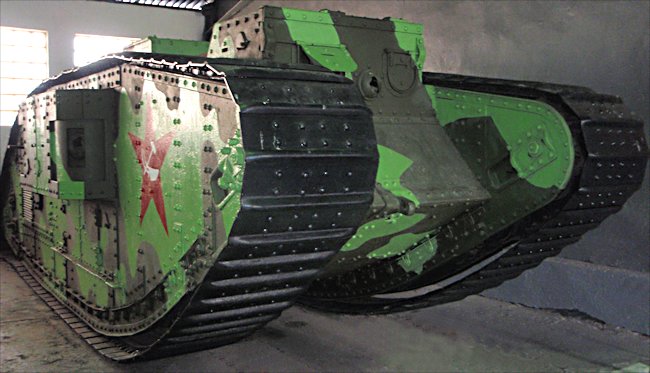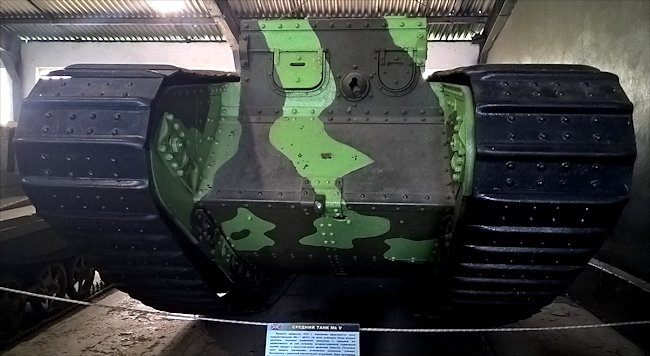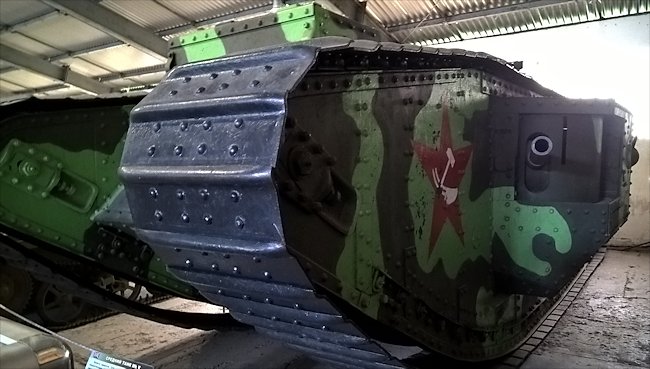MkV Composite Tank
This preserved WW1 Russian Mark V Composite 'Hermaphrodite' Tank can be found in the Kubinka Tank Museum, Russia. It was captured by the Red Russians from the Western backed White Russians during the civil war that broke out after World War One.

Surviving WW1 Russian Mark V Composite Hermaphrodite Tank can be found in the Kubinka Tank Museum, Russia This is the 'Female' side with the machine guns.
The British Mark V female tanks were designed to attack German infantry emplacements not engage in tank on tank battles. A decision was made to give them the fighting chance by adding a male six pounder cannon to one side of the vehicle. It went into the same positions forward facing machine gun. These tanks were given the nickname Hermaphrodites but officially known as Mark V Composite tanks.

Preserved Red Army Mark V Composite Tank at the Kubinka Tank Museum, Russia armed with a machine gun at the front.
Why was there a need for tanks in WW1?
Time after time the attacks began with preliminary barrages, whistles blowing and men going over the top. Unfortunately, all too often the enemies wire entanglements would slow down the attack and then the machine guns would finish it off for good. Somehow, the wire and enemy guns would need to be overcome and only then could the trenches be bro. ken, thus making it possible for the war to move again.
This became know as 'The Riddle of the Trenches' This apparently unsolvable dilemma lead to one of the most exciting and pivotal arms races of all time. At last, after several failed prototypes and unworkable machines, on 15th September 1916 the mythical, trench busting weapon made its debut for the Allies at Flers on the western front.
The new machines were known variously as Landships, Machine gun Destroyers, Armoured Toads, Trench Dreadnaughts, Big Willies, Ospreys, Buses or Snarks. Finally they became officially designated as 'Tanks' and this simple ambiguous title would become feared throughout the world. At last the Tank had been created and surely now the war would be over in a matter of days?

Surviving WW1 Russian Mark V Composite Hermaphrodite Tank can be found in the Kubinka Tank Museum, Russia This is the 'Male' side with the 6 pounder QF cannon.
Unfortunately due mainly to the unprecedented urgency attached to the creation of this new weapon, the Tank was a rush job and had been constructed mainly from 'off the peg' parts and materials. William Foster and Co Ltd of Lincoln had created the first machines by using little more than flat boiler-plate and parts from agricultural vehicles already in their range although it was a well-engineered and very capable piece of forward thinking technology it was not quite the war winner that everyone had hoping for.
The desperate need for the Tank was too far ahead of the technology available to physically build it. As if this wasn't bad enough, perhaps an even bigger problem was that the first Tanks were a completely new creation, untested, like nothing ever made before and with no precedent as to how to use them in battle.
Special tactics for Tank warfare and crew training were months away and the people who planned the battles and directed the Tanks had no idea what they could and couldn't do. The military 'Top Brass' had been told that a Tank was impervious to just about any calibre of gun fire and that, thanks to its tracks, it could cross any type of terrain, regardless of shell holes, wire, trenches or flooding.
Despite heroic efforts from the Tanks and their crews, the Generals would soon realize that most of the initial hype was far from true. The first Tanks needed constant maintenance, were underpowered, heavy, slow and difficult to control. They were ideally suited to large scale anti-personnel work on flat, unbroken ground. The first attacks using a handful of Tanks on the desolate and sodden battlefields at Flers and Ypres were near disasters and almost brought about the end for the new invention before it had even had a chance to fight.
There were calls from many in Government and in the military to end the madness and scrap the Tanks before any more lives and money was wasted, Despite this, the Tank crews still had faith in their machines and knew that if they could only get the chance to prove their worth away from the quagmires of Belgium they could change everyone's minds and perhaps even change the course of the war.
The Tanks and their crews finally got the chance they had been waiting for on the 20th November 1917 when they assembled on mass for the now legendary Battle of Cambrai, A total of 476 Tanks were fielded for the first day of the battle and along with their supporting infantry they pushed the enemy further than anyone could ever have dreamed and back in England church bells were rung in celebration of the great victory of the Tanks.
Regrettably the Battle of Cambrai was not the victory it had first appeared to be, At the end of the first day, 179 out of the original 476 machines had been lost, due to enemy fire, break downs or being ditched on unsuitable ground. The Tanks gains were not properly exploited by the supporting infantry and cavalry, a Tank is perfect for taking enemy positions, but is not very good for holding them. When the inevitable German counter-attack came, they pushed the British right back again, almost back to where they had started from on the first day.
This been blamed on a number of factors such as poor leadership at General Headquarters or the fact that the cavalry failed to turn up as arranged. It is just as likely that the failure to exploit the gains was purely because nobody had expected the Tanks to advance as far as they did.
Whatever the reason, the battle finally ended as a virtual draw in men lost and ground taken, but it had shown what could be achieved by a disciplined crew in the latest Mark IV on good ground. Now that the Generals were clear on just what a Tank could really do, their place in the British Army was never in question again.
Due mainly to overoptimistic reports in the press, back on the Home Front the British public was completely unaware of the tactical shortcomings of The Battle of Cambrai. They feverishly embraced the Tank as their saviour, the industrial and scientific solution to the new technological war that they had been expecting since 1914.
The men of the Tank Corps had always believed vehemently in the new weapon and knew that it could change the Allies fortunes if only it was given the chance it deserved, Cambrai was that chance and they had seized it with both hands. The Tanks played a pivotal part in many battles of the Great War and although badly mauled in the German push of March 1918, they fought back and helped secure final victory when the British pushed back at Amiens.
The Allies 'Big Push' began on the 8th August 1918 and was famously described by the German General Ludendorff as 'the blackest day of the German army'.
Civil War tank books

